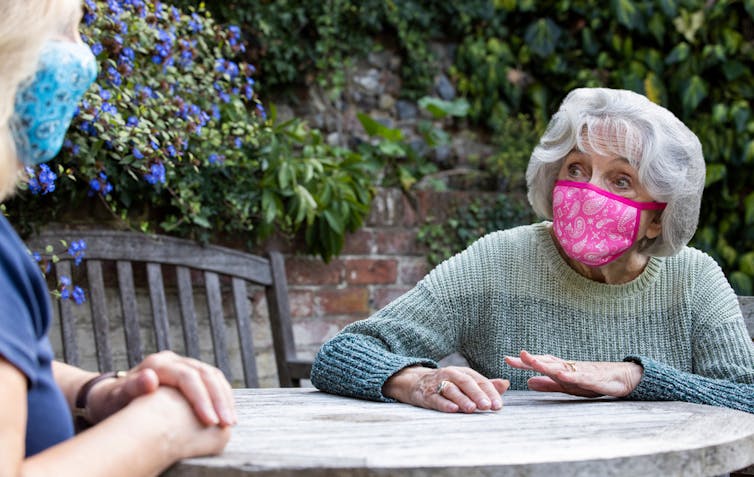Comment | The pandemic transformed how social work was delivered – and these changes could be here to stay

Since the beginning of the pandemic, a lot of attention in the UK has focused on the challenges of continuing to deliver healthcare. But a related field – social work – has also faced many challenges in maintaining “business as usual” for those using it.
People in need of support from social workers – children, older adults, people with physical or learning disabilities – are often society’s most vulnerable. They are people facing social issues and challenges, including poverty, discrimination or past trauma, such as physical abuse.
Social workers work with these people, and sometimes their families, so that they can access the support they need to improve their lives. It is challenging work, made more difficult by COVID restrictions. To continue providing care during the pandemic, social workers often had to make difficult decisions and adapt quickly to new ways of working with little or no time to prepare.
To understand how they managed, we interviewed British social workers based in the West Midlands about their experiences of working during the first wave of COVID in the spring of 2020. We wanted to find out how social workers adapted to new ways of working during the pandemic and how these changes affected the services they delivered.
A rapid move online
Our research found that the effect of switching from doing social work face to face to online – almost from one day to the next – was huge. This had negative effects both for those delivering social work and those receiving it but also, perhaps unexpectedly, some positive effects too.

Social workers had to provide services over the telephone or via video calls. Some felt uneasy about relying heavily on digital technology and thought that the quality of the service provided decreased. Our research also found that remote working potentially limited social workers’ ability to spot problems or raise concerns with those receiving social care or support.
Face-to-face work is a powerful tool for identifying issues people might be facing, such as the risk of domestic violence or self-neglect. When social workers and people they work with cannot be in the same room, it can be difficult for the social worker to get a full picture of what is happening. As one social worker we interviewed said:
I think it’s quite worrying that you may potentially be speaking to a victim of domestic abuse and trying to get an understanding of that person’s relationship, but you’re missing all the body language and cues. And you don’t really know if the perpetrator of the domestic abuse is present during that conversation, and therefore the information they provide you may be limited due to their environment.
Some social workers continued to see people face to face. However, they relied on service users being honest about their potential COVID symptoms. Some social workers described either themselves or colleagues being put at unnecessary risk as a result. They would turn up on the doorstep, and the person they were due to see would be coughing, but they had not informed the social worker beforehand that they were feeling unwell.

There were, though, positives to come out of moving social work online. Some of those we interviewed appreciated being able to work more flexibly and independently. Others said that their interactions with younger people and their families improved after moving online. Social workers described being able to engage younger people in online activities to support their mental health, and noted that working online made directing young people to other support services and sharing tasks for them to complete easier too.
However, they raised concerns about low-income families, older adults and people with learning disabilities lacking access to digital technology. These people have been referred to elsewhere as the “forgotten vulnerable”, and the pandemic seemed to exacerbate the digital divide they already experienced.
The shape of things to come?
We also found that social workers had concerns about the long-term effect of these changes. Particularly, they were worried that the changes had revealed the potential to reduce costs and that, in the long term, maintaining these changes would lead to reductions in service quality.
Delivering social work over the phone or via online video calls reduces the need for social workers to travel to people’s homes. Those responsible for funding social work services would probably find such opportunities to minimise costs attractive. Potential environmental benefits from lower vehicle emissions due to less travel also cannot be ignored.
However, there have been growing calls for greater investment in social work and for quality to be prioritised above cost. Online working could mean social workers miss important needs service users have. Making permanent the move to online therefore goes against what professionals have said is needed. One social worker phrased it as follows:
In relation to longer-term impact, I think it’s perhaps anxieties that this virtual working is going to be perhaps taken forward in the future. I certainly think we will be changing the way we work, absolutely. If it will save time to be able to focus on work more, that’s great, but not at the expense of vulnerable people in the community.
As COVID restrictions are removed and more and more face-to-face contact in other areas of life resumes, it will be interesting to see whether these attitudes towards online social work change. The pandemic has significantly raised older people’s need for social work services, and so, despite the reservations of social workers themselves, calls for changes similar to those seen during the pandemic – which potentially can increase the amount of social work delivered – may grow.![]()
Tom Kingstone, Lecturer in Mental Health, Keele University and Lisa Dikomitis, Professor of Anthropology and Sociology of Health, Keele University
This article is republished from The Conversation under a Creative Commons license. Read the original article.
Most read
- Keele University partners with Telford College and NHS to teach new Nursing Associate apprenticeship in Shropshire
- Emotion aware chatbot developed by Keele scientists offers transformative potential for mental health care
- First study of its kind sheds new light on Britain’s ‘forgotten’ World War Two decoy sites
- Keele cardiologist travels to Ethiopia to improve care for heart patients
- Keele academic wins prestigious prize for short story set in Stoke-on-Trent
Contact us
Andy Cain,
Media Relations Manager
+44 1782 733857
Abby Swift,
Senior Communications Officer
+44 1782 734925
Adam Blakeman,
Press Officer
+44 7775 033274
Ashleigh Williams,
Senior Internal Communications Officer
Strategic Communications and Brand news@keele.ac.uk.

